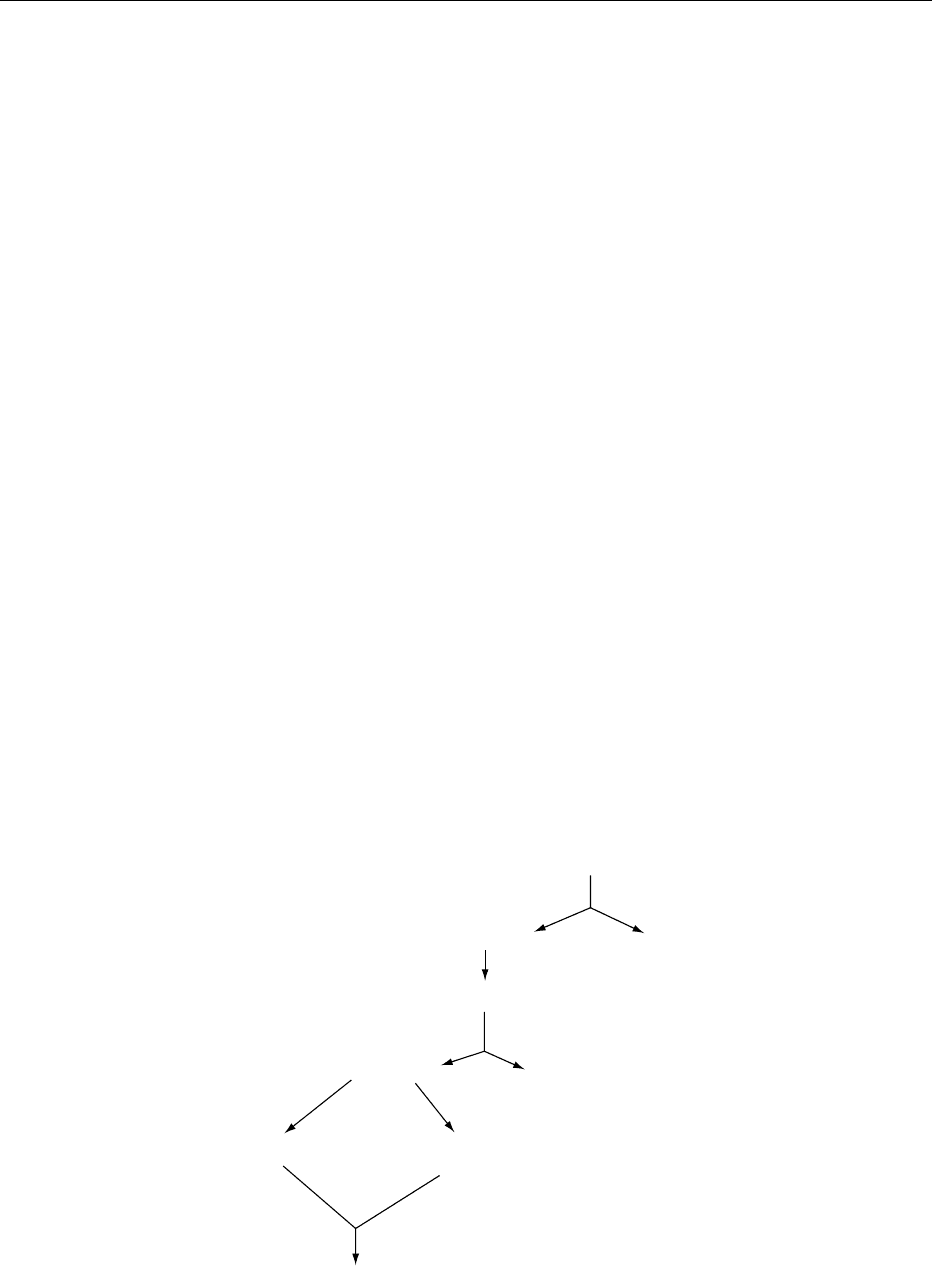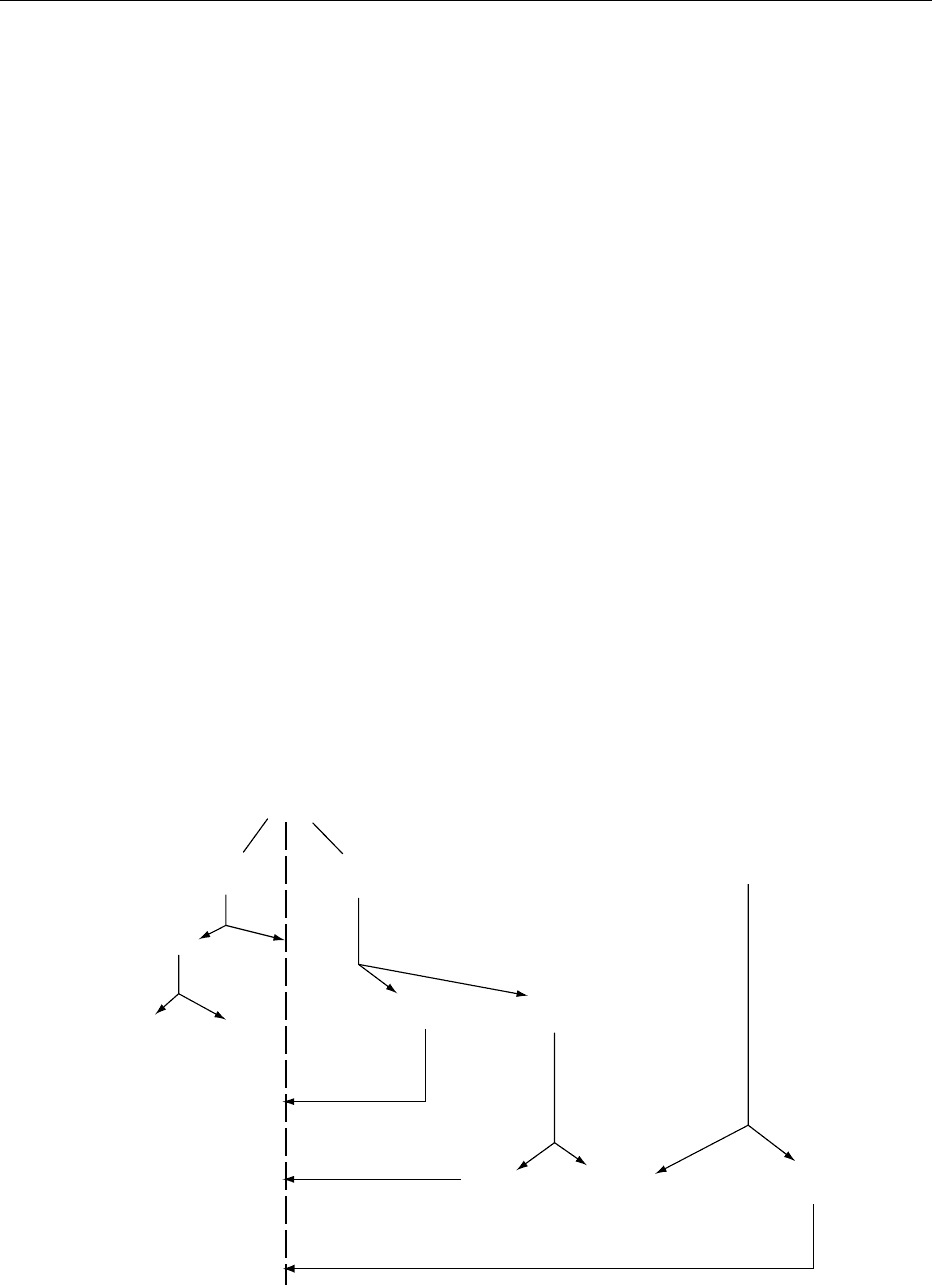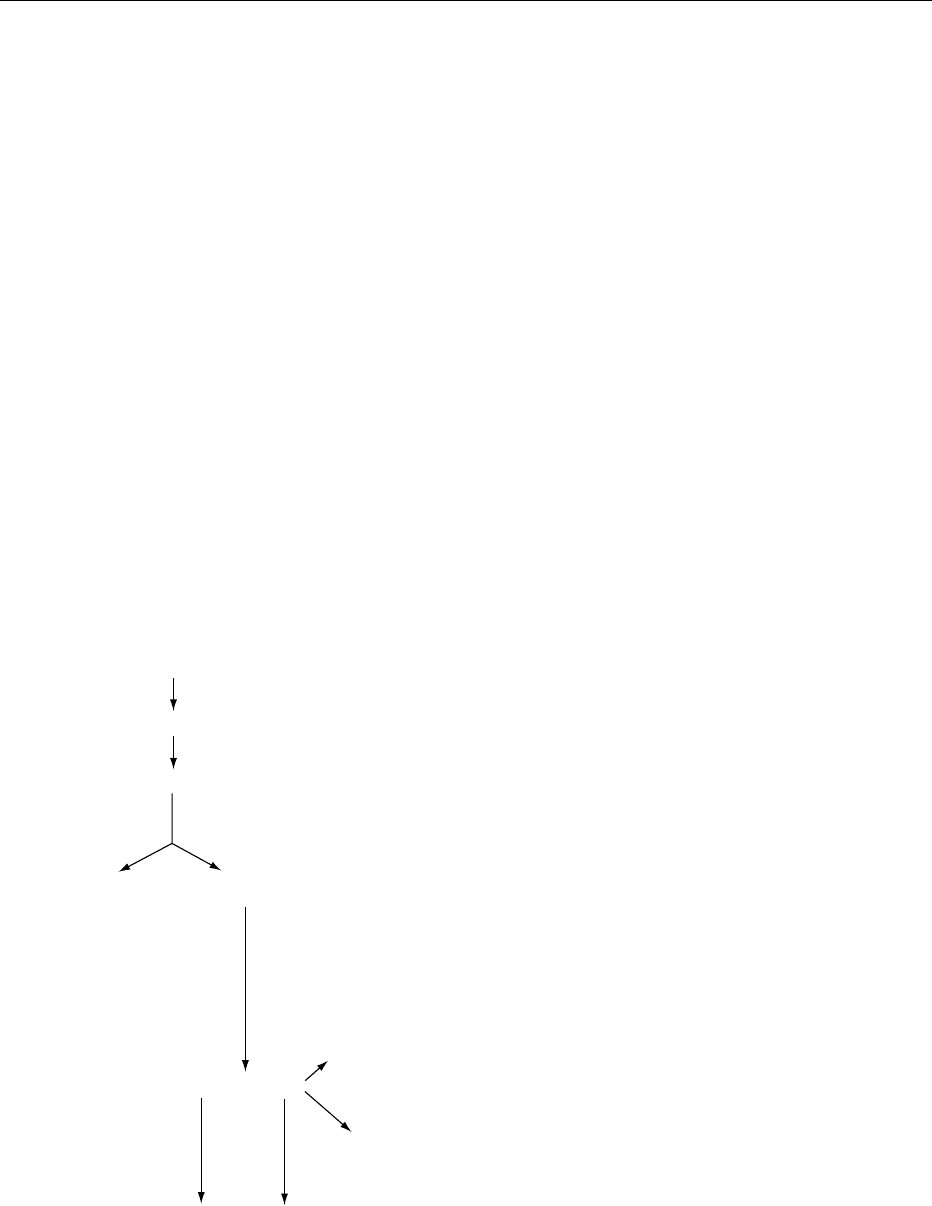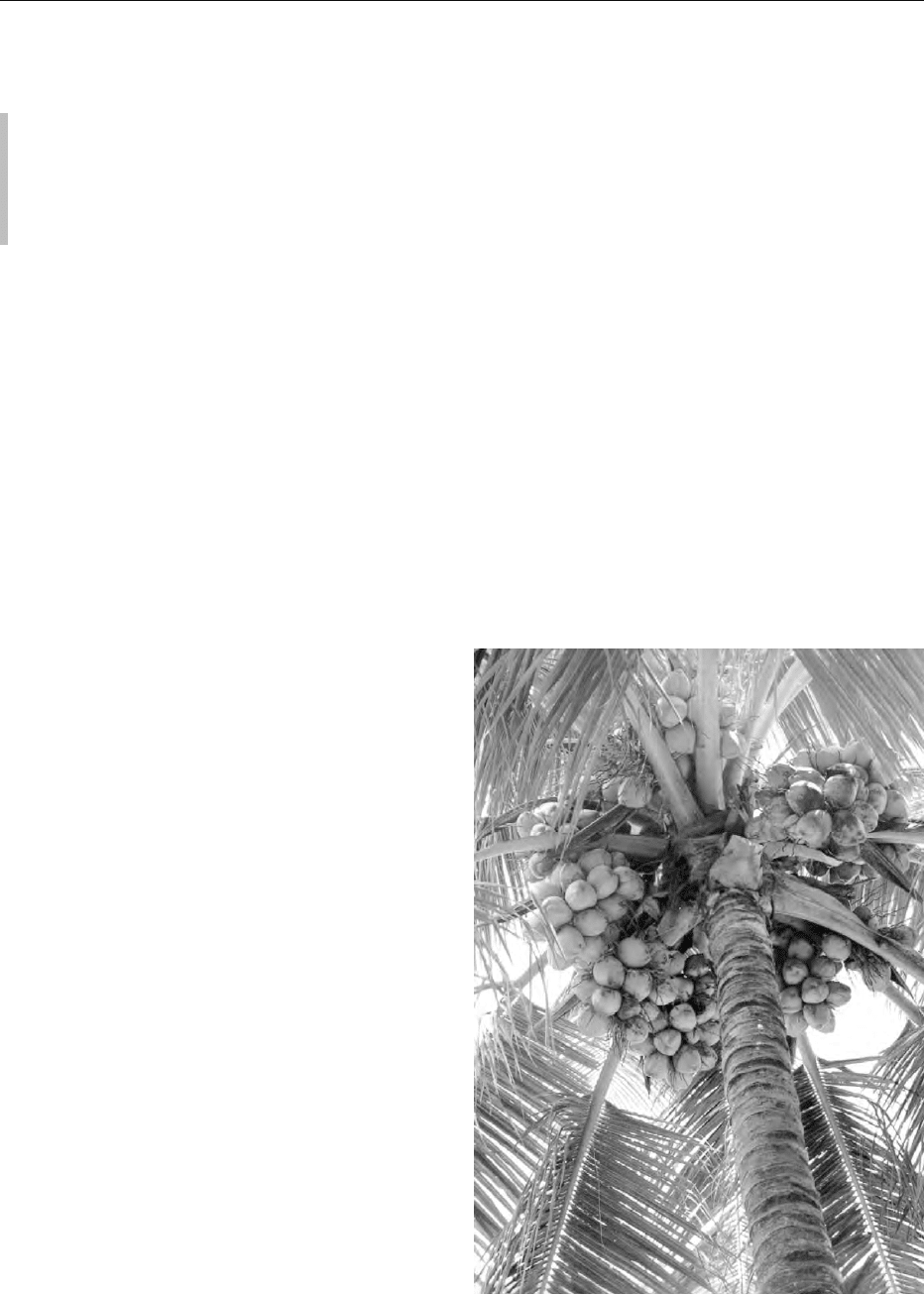Caballero B. (ed.) Encyclopaedia of Food Science, Food Technology and Nutrition. Ten-Volume Set
Подождите немного. Документ загружается.


shown in Figure 4 is not fully in balance. The choc-
olate industry needs a certain quantity of cocoa butter
and this implies that a fixed quantity of cocoa powder
is also produced. However, the demand for cocoa
powder does not always meet this volume. As a result,
the price of cocoa butter is usually substantially
higher than that of cocoa powder. The relatively
high price of cocoa butter has made it attractive to
lipid chemists to look for cheaper fats which could
replace cocoa butter. This is not easy, as cocoa butter
has unique properties, especially hardness and
melting behavior. In the course of time, cocoa butter
substitutes (CBSs) were developed, mostly based on
palm kernel fat. These are used in combination with
cocoa powder for manufacturing imitation chocolate,
or coatings (for biscuits, cakes, icecream, etc). Re-
cently, ways have been found to separate the desired
triacylglycerols from other fats and to put them to-
gether in the right proportion, thus obtaining a fat
that closely resembles cocoa butter. Such a fat is called
a cocoa butter equivalent (CBE) and can replace
cocoa butter in chocolate (Figure 5).
Quality Aspects
0047 Cocoa powder is sold in retail packages to con-
sumers. However, most cocoa powder reaches the
consumer as a color and flavor in other products,
like dessert powders, sterilized chocolate milk, choc-
olate cake, icecream, etc. Most of the cocoa powder
produced is sold as an ingredient to other food manu-
facturers. Such a product should have the necessary
quality aspects to meet the needs of the user,
regarding microbiology, consistency, purity, and
other factors. In the case of cocoa powder this can
only be fulfilled when maintaining strict good manu-
facturing practices, the reason being that there are a
number of problems which put cocoa powder in a
high-risk category:
.
0048Cocoa beans undergo a fermentation process,
which leaves very high bacteria counts on the
bean shell.
.
0049During fermentation the temperature goes up to
50
C, which leaves thermoresistant spores on the
bean. These may interfere with the sterilization
process of chocolate milk.
.
0050After fermentation, the cocoa beans are dried in the
open air, allowing contamination with bird drop-
pings. Salmonella bacteria can thus be found on
crude cocoa beans.
.
0051Bacteria which are present in cocoa mass are sur-
rounded by fat during the grinding process. The fat
gives them good protection and it has been shown
that Salmonella can live for months in chocolate.
Also, the bacteria will be protected in the stomach
against its natural acidity when chocolate is eaten.
.
0052Cocoa powder is used in many different foodstuffs,
made with different manufacturing processes, re-
quiring different shelf-lives, and having different
moisture contents. As the cocoa manufacturer
does not always know how the powder will be
used, all the product must meet the strictest hygiene
specifications. (See Spoilage: Bacterial Spoilage.)
Environment
0053The cocoa-processing industry is not one of the major
polluters of the environment. The raw materials and
the products are simply too expensive to be discarded.
Of course, there are the general problems of each
factory, such as noise and high, ugly buildings. How
these can be avoided is well known and is taken into
consideration when new chocolate factories are built.
The main problem comes from the smell of exhaust
gases – air blown through the grinding systems and
combustion gas from the roasters. These gases also
contain dust. To collect the dust, cyclones are used on
a large scale in the cocoa industry. Biological filters
are being tested for the removal of odors but they
have not been completely successful. The present
method of solving the problem is to build high chim-
neys. Cocoa bean-processing gives one waste product
– the shell, about 10% of the weight of the beans.
This loose material is usually ground to reduce its
volume and sold to fertilizer or cattle feed manufac-
turers. Burning the shell could be worthwhile when
energy costs are high, but introduces the problem of
removing large quantities of dust from the combus-
tion gas.
Production of Cocoa Mass
0054All cocoa beans are initially turned into cocoa mass.
The necessary processes are illustrated in Figure 6.
The word ‘nib’ is used in all languages to indicate the
CBS
Coating
Cocoa powder
Cocoa butter
Cocoa massCocoa beans
CBE
Chocolate
fig0005 Figure 5 The use of alternative fats to cocoa butter. CBS, cocoa
butter substitute; CBE, cocoa butter equivalent. Reproduced from
Cocoa: Production, Products and Uses. Encyclopaedia of Food
Science, Food Technology and Nutrition, Macrae R, Robinson RK
and Sadler MJ (eds), 1993, Academic Press.
1456 COCOA/Production, Products, and Use

broken pieces of the kernel of the cocoa bean. Cocoa
mass contains approximately 55% cocoa butter. The
fat is liquid after the roasting and grinding proced-
ures, which make the whole mass liquid. It can be
pumped and transported in tank lorries.
0055 Cleaning Cocoa beans, from silo storage or directly
from their burlap bags, first pass through cleaning
machines – screens, magnets and controlled air
streams. Extraneous materials removed include
sticks, stones, string, and metal objects.
0056 Blending Substantial variety in flavor exists among
cocoa beans from different countries. It is seldom that
one batch of beans will be used exclusively in a for-
mula. One reason is that blending provides the op-
portunity to obtain a certain flavor. Another reason
stems from the inconsistency of cocoa beans in flavor
and other quality aspects. Batches of cocoa beans
show variations from one locality to another, due
to differences in the weather during growth and
ripening, from differences in fermentation and other
variations in processing conditions. Blending will
contribute to uniformity.
0057 Thermal pretreatment An important quality aspect
in cocoa bean processing is removal of the cocoa shell.
The shell, as the covering of the kernel, is always
greatly polluted with sand, high bacteria counts, and
pesticide residues. Depending on the fermentation,
the shell often sticks to the kernel, which prevents
easy removal. Recently machines have been intro-
duced which loosen the shells by means of a thermal
shock. This is achieved with hot air, saturated steam,
or infrared radiation.
0058Breaking and fanning To remove the shell, the
beans are first broken between adjustable toothed
rollers. The broken pieces are subsequently separated
in fractions by sieving. Each fraction is treated with a
stream of air which carries away the light shell pieces.
This breaking and fanning process is often referred to
as ‘winnowing.’
0059Roasting The roasting process at 120–140
Cis
needed for the development of the typical flavor of
cocoa. Using modern technology, cocoas can be
roasted at different particle sizes, such as whole
beans, or as liquid cocoa mass, which is produced
by a fine grinding of cocoa and liquefying within its
own fat. The roasting of smaller particles has the
advantages of better controlled roasting, partial
exhaustion of abundant acetic acid, and reduced
roasting time (beans take about 30 min, nibs 12 min,
mass 2 min). The type of roasting technique may also
influence microbiological aspects. The bacteria pre-
sent are on the shell and by removing the shell first the
material enters the roasting (¼ sterilization) process
with a lower initial bacteria count.
0060Grinding and refining The next step is grinding
of the cocoa nib particles. The nib consists of 55%
cocoa butter and 45% solid material coming from the
plant cells. The latter must be ground very finely.
When eating chocolate or drinking chocolate milk,
no grittiness should be felt in the mouth. For both
cocoa powder and chocolate it is important that the
final particle size distribution is narrow. This facili-
tates the pressing operation and improves the rheo-
logical properties of chocolate. The desired fineness
(15–70 mm) and particle size distribution are reached
in several successive grinding steps. Pregrinding of the
large and hard nib particles is done in disk mills,
hammer mills, or pin mills. To reach the ultimate
fineness, mass for pressing is refined in modern ver-
sions of the triple stone mill, or in vertical ball mills
(attrittors). In the chocolate industry, roller mills with
five rolls are most commonly used for refining the
mass. These are also used to grind the chocolate
mass, after adding preground sugar and milk powder.
(See Milling: Characteristics of Milled Products.)
0061Types Cocoa mass may be used for the production
of chocolate, or for pressing, i.e., in the production of
cocoa butter and cocoa powder. The difference be-
tween these two types of cocoa mass are the bean
Cocoa beans
Cleaning
Blending
Thermal pretreatment
Breaking and fanning
Roasting
Cocoa shellCocoa nib
Grinding
Cocoa mass
fig0006 Figure 6 The production of cocoa mass. Reproduced from
Cocoa: Production, Products and Uses. Encyclopaedia of Food
Science, Food Technology and Nutrition, Macrae R, Robinson RK
and Sadler MJ (eds), 1993, Academic Press.
COCOA/Production, Products, and Use 1457

blend, fineness, and microbiological condition,
among others.
0062 For chocolate, many manufacturers prefer beans
from Ghana and Nigeria on account of their desirable
flavor attributes. For the highest qualities, South
American so-called flavor beans may also be added
to the blend.
0063 Although for all purposes mass needs to be com-
pletely safe from the bacteriological point of view,
cocoa powder requires, moreover, that thermoresis-
tant spores are absent. This condition must already
have been reached in the mass, which tolerates higher
temperatures than cocoa powder.
0064 Mass for pressing is also already alkalized. This
process will be discussed below.
0065 Packaging and shelf-life When cocoa mass has to be
stored or transported, it is usually packed into 30-kg
cardboard boxes with a plastic liner or bag inside. In
Europe and the USA most of the transport takes place
in liquid form.
0066 Cocoa mass has a very good shelf-life. The solid
particles are protected by a fat with a high degree of
saturation. Moreover, cocoa contains powerful nat-
ural antioxidants. These conditions also apply to
cocoa beans. If the moisture content of the beans is
well under control, their shelf-life will be several
years. (See Antioxidants: Natural Antioxidants.)
0067 Production of cocoa butter Cocoa mass contains
55% cocoa butter. Part of this can be extracted by
mechanical pressing. The solids which stay in the
press contain 22% fat, or even as low as 10%.
These press cakes are ground to cocoa powder. The
cocoa butter is filtered and part of it is deodorized.
The production process is illustrated in Figure 7.
0068Pressing The cocoa mass is pumped to horizontal
hydraulic presses, with pots lined up face to face, each
equipped with very fine mesh metal filter screens.
When all the pots are filled with mass at a tempera-
ture of 90
C, the hydraulic ram is set in motion and
the cocoa butter begins to flow through the screens on
both sides of each pot. The pressure then increases to
400 bars. The hard cocoa cakes remaining are then
discharged from the press. The cocoa butter collected
from the press is not ‘clean,’ having carried with it a
small amount of tiny nonfat particles. It is therefore
filtered through filter paper.
0069Deodorization and blending Crude cocoa butter has
a strong flavor. This is desirable in dark chocolate.
However, in milk chocolate much more cocoa butter
is used and the cocoa flavor would become too
strong, suppressing the milk flavor. Thus, buyers are
stipulating a cocoa butter with a weak flavor, or no
flavor at all. This is reached by steam deodorization
of the cocoa butter and blending crude and deodor-
ized butter to the desired flavor. This is controlled by
sensory testing, or a chemical method, the determin-
ation of the flavor profile. Crude cocoa butter, being a
natural product, has a rather inconsistent flavor
strength. Even if crude cocoa butter is asked for,
some blending with deodorized butter is performed
Cocoa beans
Cocoa shellCocoa nib
Cocoa mass
Pressing
Cocoa butter
Deodorizing
Deodorized
butter
Blending
Cocoa butter
Crude
butter
Press cake
fig0007 Figure 7 The production of cocoa butter. Reproduced from Cocoa: Production, Products and Uses. Encyclopaedia of Food Science,
Food Technology and Nutrition, Macrae R, Robinson RK and Sadler MJ (eds), 1993, Academic Press.
1458 COCOA/Production, Products, and Use

to standardize the flavor. (See Sensory Evaluation:
Taste.)
0070 Properties Cocoa butter is one of the most expen-
sive natural fats. This is due to its unique melting
behavior. Cocoa butter has a much narrower melting
range than any other fat. This quality is fundamental
to chocolate. Chocolate should be hard – even in hot
weather – and it should not stick to the fingers. At
room temperature, about 70% of the triacylglycerols
in cocoa butter are solid. On eating, the cocoa butter
in the chocolate should melt completely in the mouth
and cause a pleasant taste sensation due to the con-
sumed melting enthalpy. The relatively narrow
melting range of cocoa butter is important in the
production of chocolate. When the chocolate is
cooled and the fat solidifies, a considerable decrease
in volume takes place. This contraction makes it easy
to release chocolate articles from their molds.
0071 Types The above discussion has been restricted to
the processing of sound cocoa beans, from which the
shell has been properly removed. The fat derived from
this raw material is called prime pure pressed cocoa
butter. In practice, not all cocoa beans that are har-
vested are of a good quality. Even if the beans are
unripe, moldy, or smoky, they contain a fat that can
be made fully fit for human consumption by refining.
When processing subgrade cocoa beans, it is difficult
to remove their shells. Such beans are processed
whole in continuous expeller presses. The resulting
press cake still holds another 10% of fat, which can
be obtained by solvent extraction. The remaining
solids are, of course, not edible and are best put
back on the land as a fertilizer. Although the fat will
be edible after refining, the quality is inferior to the
prime pure pressed butter. It is less hard and shows a
smaller volume contraction. The following types of
subgrade cocoa fat are recognized by the Codex
Alimentarius:
1.
0072Expeller cocoa butter: the fat extracted by means
of mechanical pressing from material which has
approximately the composition of whole cocoa
beans.
2.
0073Solvent-extracted cocoa butter: the fat obtained
from cocoa beans or cocoa waste materials by
means of extraction with permitted solvents.
3.
0074Refined cocoa butter: any of the fats obtained in
the ways mentioned above and afterwards fully
refined according to the standard processing tech-
niques for edible oils and fats.
4.
0075Cocoa fat: fat extracted from waste materials and
having a quality below certain standards.
The above processing options are summarized in
Figure 8.
0076Packaging, transport, and shelf-life Much like
cocoa mass, cocoa butter is packed in 30-kg slabs or
transported and stored in a liquid form. The shelf-life
Cocoa beans
Good
grade
Sub-
grade
Nib
Shell
Hydraulic
pressing
Cocoa
powder
Expeller pressing
Press
cake
Crude
butter
Deodorizing
Solvent
extraction
Crude
butter
Defatted
solids
Cocoa
fat
Refining
Cocoa
butter
Expeller
butter
Refined
butter
Refined
cocoa fat
Wastes
Solvent
extraction
EDIBLE NONEDIBLE
fig0008 Figure 8 Types of cocoa butter. Reproduced from Cocoa: Production, Products and Uses. Encyclopaedia of Food Science, Food Tech-
nology and Nutrition, Macrae R, Robinson RK and Sadler MJ (eds), 1993, Academic Press.
COCOA/Production, Products, and Use 1459

of cocoa butter is good, due to its high degree of
saturation, and the shelf-life of solid cocoa butter is
several months to a year, if properly packed and
stored.
Production of Cocoa Powder
0077 The press cakes are ground to powder, which is
packed after complete cooling. The alkalizing process
can be used to create many types of cocoa powder
with differing colors. The production of cocoa
powder is shown in Figure 9.
0078 Alkalizing The alkalizing process was invented in
the first half of the 19th century in the Netherlands.
It improves the quality of cocoa powder in two ways:
1.
0079 It takes away the slightly acid taste of cocoa.
2.
0080 It makes the color darker. This is due to condensa-
tion reactions forming high-molecular-weight
colored products. Careful control of the reactions
can lead to different shades of color: orange, red,
brown, and even black is possible.
0081Alkalizing consists of treating the cocoa with a
solution of an alkali, mostly potash. Legally, the max-
imum amount of potash which may be used is 3%,
calculated on the nib. The treatment can be per-
formed with the nib, mass, press cake, or powder.
The specific color is reached by choice of the reaction
conditions: temperature, time, amount and concen-
tration of the alkaline solution, and other factors.
0082Grinding, cooling, and blending of cocoa cake The
press cakes are broken and then ground to powder in
pin or other mills. The cocoa powder leaves the mill
hot. It should be completely cooled before packing,
otherwise the setting fat will turn it into hard lumps
inside the package.
0083Blending of pieces of broken cake before grinding
allows standardization of the color, or the prepar-
ation of blends with intermediate colors.
0084Types Variations in the two main processes lead to
the formation of hundreds of different types of cocoa
powder. The pressing can be performed to a fat con-
tent in the cake of 20% (giving cocoa powder) or to
10% (giving low-fat cocoa powder), while the alka-
lizing process creates many different colors. Cocoa
powder with 20% fat is the common household
type. The food industry uses mostly low-fat cocoa
powder (10%), in many different colors.
0085For use in certain cocoa-flavored products, some
special types of cocoa powder have been developed.
Lecithinated cocoa powder contains 5% of soya leci-
thin. Owing to its fat content, cocoa powder is diffi-
cult to wet and to disperse in water. Even in hot water
or milk, lumps will be formed easily. Lecithin can
improve these properties by its action as a wetting
agent. Five percent of soya lecithin is intensively
mixed with cocoa powder and the resulting lecithi-
nated powder is agglomerated with sugar. This gives
so-called instant cocoa, which can be put directly into
cold milk. (See Emulsifiers: Organic Emulsifiers.)
0086Stabilized cocoa powder contains about 2% carra-
geenan. This is a polysaccharide derived from sea-
weed. It prevents the cocoa powder from settling in
sterilized chocolate milk. (See Stabilizers: Types and
Function.)
0087Packaging, transport, and shelf-life Paper or tin
retail packaging is well known. For bulk deliveries,
25-kg (or 50-lb) multiple paper bags are commonly
used. Loose bulk delivery or storage of cocoa powder
is difficult. The fat-containing fine powder tends to
stick and to block pipelines for pneumatic transport.
Only large users, in cooperation with large suppliers,
have developed workable bulk systems. The shelf-life
of cocoa powder is excellent. Even after 10 years the
Cocoa beans
Cocoa nib
Cocoa mass
Roasting
Grinding
alkalizing
Pressing
Cocoa
butter
Press
cake
Grinding
Cooling
Blending
Retail sales
Industrial use
+ Stabilizer
Cocoa powder
Lecithinated
cocoa powder
Stabilized
cocoa powder
+ Lecithin
fig0009 Figure 9 The production of cocoa powder. Reproduced from
Cocoa: Production, Products and Uses. Encyclopaedia of Food
Science, Food Technology and Nutrition, Macrae R, Robinson RK
and Sadler MJ (eds), 1993, Academic Press.
1460 COCOA/Production, Products, and Use

flavor is good when packed in air- and moisture-proof
containers. Only some fading of the color may be
noticed, comparable with fat bloom on chocolate.
This disappears when the cocoa is used in milk.
Production of Chocolate
0088 The major ingredient of chocolate is cocoa mass,
which is mixed with sugar and, in the case of milk
chocolate, also with milk powder. The conching pro-
cess then follows, which is very important for the
development of the full chocolate flavor. Melted
cocoa butter is added, the chocolate mass becomes
liquid, and is cooled, tempered, and poured into
molds to form chocolate products (Figure 10).
0089 Mixing of ingredients and refining Sugar, cocoa
mass, and milk powder are intensively mixed,
forming a dry powder. This powder is preground in
various types of mills and then finely ground in a five-
roll roller refiner. Small operators also use vertical
ball mills. The sizes of particles in chocolate are
between 15 and 70 mm.
0090 Conching The flavor which has been formed during
roasting is rounded off into the typical chocolate
flavor by the conching process. This process also
contributes to the physical properties of the choc-
olate, and hence its eating characteristics. Conching
is a mechanical treatment of the chocolate mass in
large containers fitted with rollers, paddles, or a var-
iety of other devices. Chemical and physical changes
take place under the influence of air which is brought
into the mass, at a temperature of about 60
C, and of
rubbing and shearing forces. The result is the forma-
tion or liberation of flavor components which give the
delicate chocolate note. The chemistry of this process
is largely unknown. Physically the dry, crumbled mass
is converted into a flowable liquid suspension. The
sharp edges of the sugar particles are rounded off,
which will give the chocolate a smooth feeling in the
mouth.
0091Three phases can be distinguished in conching:
1.
0092Dry phase: the powdered chocolate mass loses
moisture and less desirable volatile flavor com-
ponents like acetic acid.
2.
0093Pasty phase: during dry conching the mass be-
comes pasty. Flavor development takes place
under the influence of shearing forces.
3.
0094Liquid phase: the last component, cocoa butter, is
added. The chocolate mass becomes liquid.
Homogenizing takes place under the influence of
intensive stirring and shearing.
0095The final degree of viscosity is very important: the
melted chocolate must be sufficiently thin to fill all
cavities of the molds. The melted cocoa butter is the
liquid phase. However, this is the most expensive
component of chocolate. A substantial saving of
butter can be obtained by using an emulsifier. Soya
lecithin (0.3%) is the most commonly used emulsifier
which is added during the third conching phase.
0096A special way to produce milk chocolate is from
crumb. The sugar and cocoa mass are brought into
liquid milk and the whole is dried. During the lengthy
drying a caramel flavor is developed. Dry milk choc-
olate crumb has a good shelf-life, due to the natural
antioxidants of cocoa. To make chocolate, only cocoa
butter has to be added. Crumb is much used in
the UK.
Cooling and Tempering
0097Critical to the appearance, gloss, shelf-life, and
mouth feel of chocolate is the way it is cooled before
solidifying in molds. Cocoa butter triacylglycerides
can set in several polymorphic forms. Some are un-
stable and recrystallization into the stable form will
occur after some hours or days. This will result in a
loss of gloss and the formation of white fat crystals on
the surface of the chocolate – the so-called ‘fat
bloom.’ To obtain stable crystals, stable seed crystals
must be formed first. This is done in a process called
Cocoa mass
Sugar
Milk powder
Mixing
Chocolate mass
Grinding, refining
Conching
Cooling, tempering
molding, enrobing,
packaging
Chocolate
Lecithin
Cocoa butter
fig0010 Figure 10 The production of chocolate. Reproduced from
Cocoa: Production, Product and Uses. Encyclopaedia of Food Sci-
ence, Food Technology and Nutrition, Macrae R, Robinson RK and
Sadler MJ (eds), 1993, Academic Press.
COCOA/Production, Products, and Use 1461

tempering. The liquid chocolate at a temperature of
45–50
C is cooled to 32
C, then to 27–27.5
Cand
treated by special shear elements. Shear forces en-
hance the nucleation of stable cocoa butter crystals.
The temperature is now raised to 29–31
C, causing
any crystals of unstable form to melt. The exact
temperatures required for this process depend on the
type of chocolate. After tempering, the chocolate is
ready to be poured into the molds. It is still liquid
but contains 0.1–1% of crystallized fat as seeding
material.
Molding and Enrobing
0098 Chocolate articles are made in two distinct ways.
0099 In molding, the chocolate is poured into a mold,
which then moves on a belt through a cooling tunnel.
After setting, the mold is turned upside down and as a
result of the volume contraction of cocoa butter, the
article will easily fall out of the mold. Solid bars are
then ready for packaging. It is also possible partly to
fill the mold. After filling, the mold is immediately
emptied, and a thin layer remains on the bottom and
wall of the mold. The mold is then cooled, and a
filling is poured in. After cooling, a further chocolate
layer is put on the filling: this becomes the bottom of
the candy when the mold is turned. Large filled bars
are made this way, as also is smaller confectionery.
0100 To make Easter eggs and other hollow products, a
small quantity of chocolate is poured into a split
mold. The mold is then closed and put in a shaking
machine to cool. The chocolate sets against the inner
wall.
0101 In enrobing, the liquid chocolate is poured over a
solid center. Many different products are made this
way, like candy bars, biscuits, cakes, and icecream.
The viscosity of the chocolate determines the thick-
ness of the layer. This can be controlled with the fat
content of the chocolate, which is usually slightly
higher than that of molding chocolate (Table 2).
Packaging, Storage, and Shelf-life
0102 Packaging should protect chocolate products against
moisture and against odors, which can easily be
picked up by the chocolate fat. Furthermore, of
course, the outside of the packaging must radiate
the delicacy and luxury which is the image of
chocolate. Up to now these requirements have
resulted in multiple packages: aluminum foil first,
paper or heat-sealed foil, finally a cardboard box.
Often, the combination of materials prevents reuse
and it is foreseeable that less complicated packaging
will be developed in the near future.
0103Chocolate, with its very low moisture content
(below 1%) and natural antioxidants, has a very
good shelf-life. However, rats, insects, and molds
like it just as much as humans. Thus, proper storage
is important. Another danger arises from high and
irregular storage temperatures. The latter causes the
formation of fat bloom. Although the white color of
the fat resembles mold growing on the product, the
phenomenon is completely harmless.
Food Uses of Cocoa Products
Uses of Cocoa Powder
0104Cocoa powder is used as a natural color and flavor in
a wide variety of sweet foodstuffs. These may be
solid, semisolid, or liquid, and consumed frozen or
hot. These products can be grouped in the following
way:
1.
0105Aqueous systems, consumed frozen. This is the
category to which icecream belongs. The cocoa
powder used is mostly low-fat (10%). A great
variety of colors is used to attain effects resembling
dark or milk chocolate.
2.
0106Aqueous systems, consumed at room temperature.
Examples are milk products like chocolate milk
drinks and desserts. Lightly alkalized cocoa with
10% fat is mostly used.
3.
0107Aqueous systems, consumed hot. Hot chocolate is
the product in which lightly alkalized cocoa
powder with 20% fat is used most frequently.
4.
0108Fat systems. These are coatings based on cocoa
butter substitutes, made with 10% fat cocoa and
often not alkalized (real chocolate is also not alka-
lized). Cocoa butter substitutes may be used for
the sake of economy and, indeed, their use may be
unavoidable for technical reasons. This is the case
with coatings on icecream. At the low temperature
of icecream, chocolate becomes too brittle and
softer fats are needed.
tbl0002 Table 2 Indicative composition of some types of chocolate
Cocoamass (%) Cocoabutter (%) Milk powder (%) Sugar (%)
Dark chocolate 40 10 — 50
Milk chocolate 10 20 15 55
Enrobing chocolate 40 15 — 45
White chocolate — 25 25 50
1462 COCOA/Production, Products, and Use

Uses of Chocolate
0109 Chocolate can be consumed as such, but it is also
much used as an ingredient on or in other foodstuffs.
Enrobing of biscuits and other items has already been
mentioned. Chocolate drops go into biscuits, and
chocolate is used in between wafers. The latter is an
example of the possible use of chocolate in tropical or
subtropical countries. Even if the chocolate melts, it
does not spoil the outside appearance of the product,
nor does it stick to the fingers.
Legislation of Cocoa Products
0110 General directives, serving as a guideline for national
food laws, are laid down by the Codex Alimentarius.
Based on this, the European Union has developed
harmonized directives for its member countries. The
Food, Drug, and Cosmetics Act in the USA gives
similar rules. In most of these countries the name
‘chocolate’ may only be used if no other fat is present
but cocoa butter. CBE fats, up to 5% of the total
chocolate content, may be used in the European
Union. In Japan three types of chocolate are distin-
guished: pure chocolate, chocolate, and semichoco-
late. Only the first of these may not contain fats other
than cocoa butter. See Legislation: International
Standards.
See also: Antioxidants: Natural Antioxidants; Cocoa:
Chemistry of Processing; Colorants (Colourants):
Properties and Determination of Natural Pigments;
Drying: Theory of Air-drying; Drying Using Natural
Radiation; Emulsifiers: Organic Emulsifiers; Lactic Acid
Bacteria; Legislation: International Standards; Fats:
Classification; Milling: Characteristics of Milled Products;
Sensory Evaluation: Taste; Spoilage: Bacterial
Spoilage; Molds in Spoilage; Stabilizers: Types and
Function; Storage Stability: Parameters Affecting
Storage Stability
Further Reading
Beckett ST (1988) Industrial Chocolate Manufacture and
Use. London: Blackie.
Biehl B (1995) Post harvest processing in Asia: approaches
towards flavour improvement. In: Seminar Rencontres
Cacao – les Diffe
´
rents Aspects de la Qualite
´
. pp. 75–
89.Montpellier, France: AFCC/CIRAD.
Biehl B, Meyer B, Crone G and Pollmann L (1989) Chem-
ical and physical changes in the pulp during ripening and
post harvest storage of cocoa pods. Journal of Science
and Food Agriculture 48: 189–208.
Cook LR and Meursing EH (1982) Chocolate Production
and Use. New York: Harcourt Brace Jovanovich.
Drouven H, Fabry I and Go
¨
pel G (1996) Su
¨
ßwaren-
technologie I: Schokolade. Stolberg-Vicht: Drouven &
Fabry.
Fincke A (1965) Handbuch der Kakaoerzeugnisse. Berlin:
Springer-Verlag.
Hunter JR (1990) The status of cacao (Theobroma cacao,
Sterculiaceae) in the western hemisphere. Economic
Botany 44: 425–439.
Knapp AW (1937) Cacao Fermentation: A Critical Survey
of its Scientific Aspects. London: Bale and Curnow.
Lockwood G and Eskes AB (1995) Relationship between
cocoa variety and quality. In: Cocoa Meetings – The
Various Aspects of Quality (Seminar Rencontres Cacao
– les Diffe
´
rents Aspects de la Qualite
´
), pp. 53–73, 159–
168. Montpellier, France: AFCC/CIRAD.
Martin RA (1987) Chocolate. Advances in Food Research
31: 211–342.
Meursing EH (1983) Cocoa Powders for Industrial Process-
ing. Koog aan de Zaan, The Netherlands: Cacao de Zaan.
Meyer B, Biehl B, Said M and Samarakoddy RJ (1989) Post
harvest pod storage: a method for pulp preconditioning
to impair strong nib acidification during cocoa fermen-
tation in Malaysia. Journal of Science and Food Agricul-
ture 48: 285–304.
Roelofsen PA (1958) Fermentation, drying and storage of
cocoa beans. Advances in Food Research 8: 225–296.
Rohan TA (1963) Processing of Raw Cocoa for the Market.
FAO Agriculture Studies no. 60. Geneva: Food and Agri-
culture Organization.
Wood GAR and Lass RA (1985) Cocoa, 4th edn. Harlow:
Longman.
Ziegleder G (1985) Improved crystallization of cocoa butter
under shearing. Zeitschrift fu
¨
r Lebensmittel Technologie
und Verfahrenstechnik 36: 412–416.
COCOA/Production, Products, and Use 1463

COCONUT PALM
J J Lal and C V Sreeranjit Kumar, Centre for
Development of Science and Technology, Thrissur,
Kerala, India
M Indira, University of Kerala, Thiruvananthapuram,
Kariavattom, India
Copyright 2003, Elsevier Science Ltd. All Rights Reserved.
Background
0001 This is a graceful palm, 20–30 m in height, and native
to the tropical regions of the world. Its requirement of
high humidity, abundant rainfall (60 cm) and mean
annual temperature of about 33
F makes the sea
coast its usual habitat. Characterized by tall slender
and uniformly thick stem and massive crown with a
large number of paripinnate leaves bearing bunches
of nuts in their axils, the palm enhances the natural
panoramic beauty of countries where it is extensively
cultivated. It is a long-lived plant that may live as long
as 100 years (Figure 1).
0002 The fact that the coconut palm could be found
throughout the tropics, even before the advent
of European explorers, renders the tracing of its
origin quite difficult. Coconut was first mentioned
by an Egyptian monk, Cosmos Indicopleustes in
‘Topographia Christiana’ in ad 545. The most im-
portant regions of coconut production are the Philip-
pine islands, Malaysia, India, Indonesia, and Sri
Lanka.
0003 There are several different varieties of coconut
palms, including tall and dwarf. The common tall
varieties are Ceylon tall, Indian tall, Jamaica tall,
Malayan tall, Java tall, and Laguna. Malayan dwarf,
Dwarf green, Dwarf orange, and Dwarf Fijian are
some of the dwarf varieties. Tall varieties are com-
monly cultivated for commercial purpose. Tall var-
ieties are slow to mature and produce the first flowers
6–10 years after planting. The life span of tall var-
ieties is about 60–100 years. Dwarf varieties may
grow to a height of 7.5–9 m, produce the first flowers
after 3 years, and have a life span of about 30 years.
Dwarf varieties are thought to have originated as a
result of a mutation of tall types. D T (dwarf tall)
and T D (tall dwarf) hybrids are early bearers and
are found to be superior to their parents in terms of
yield under favorable conditions. There are also sev-
eral unusual types of coconut palms in different parts
of the world. Lodoicea maldivica, a palm very closely
related to coconut is known as double coconut or
Maldive nut. Its nut is considered to be the largest
plant seed in the world and looks like two coconuts
joined together side by side. Macapuno is a Philippine
variety of the coconut palm that does not have any
water inside the coconut shell. Its ‘meat’ is a soft jelly-
like substance that is used in popular Filipino sweets.
0004Coconut palm adapts to almost all types of well-
drained tropical soils like coastal sand, red loam,
laterite, alluvial, and the reclaimed soil of the marshy
low land. A water table that is too high and remains
static for long periods is harmful, but the palm
can tolerate salinity and a wide range of pHs from
5.0 to 8.0.
0005Coconut palm is propagated with the help of seeds.
Seeds are selected from healthy, high-yielding, and
regularly bearing palms. One-year-old healthy seed-
lings with a minimum of six leaves are selected for
planting. Nine-month-old seedlings with a minimum
of four leaves can also be used for planting. The
square system of planting, with a spacing of 7.5–9m
accommodates, 124–177 palms per hectare. The
fig0001Figure 1 (see color plate 37) Coconut palm.
1464 COCONUT PALM

triangular method with a spacing of 7.6 m accomo-
dates 198 palms per hectare. In the hedge system of
planting, larger number of plants can be planted in a
unit area, ensuring sufficient light on each palm.
0006 Calopagonium muconoides, Mimosa invisa, Stylo-
santhes gracilis, etc. are cultivated as cover crops in
coconut gardens. Crotalaria juncea, Tephrosia pur-
purea, Indigofera hirsuta, etc. are grown as green
manure crops in coconut gardens. Under rain-fed
conditions, tuber crops (tapioca, yams, ginger, tur-
meric, etc.), banana, pineapple, and pulses can be
grown as intercrops in adult coconut plantations
without affecting the fertility of the soil and product-
ivity of the palms. Under irrigated conditions, plants
like cocoa form crop combinations with coconut.
Pepper, cinnamon, clove, nutmeg, etc. are ideal for
mixed cropping with coconut. Mixed farming, in-
cluding the rearing of cattle on fodder grasses and
legumes raised as intercrops with coconut gardens,
in turn yield dung, and urine is a very remunerative
form of mixed husbandry suited to farmers with small
coconut holdings. It increases the fertility of the soil
by recycling organic wastes, enhances the yield of
palms, and generates additional income and job
opportunities for the farmers.
0007 Once the palm has attained the normal bearing
stage, it continues to bear a bunch of nuts in every
leaf axil at monthly intervals throughout its life
extending over 50–60 years. The nuts mature 1 year
after fertilization. Harvesting is done once every 45 or
60 days. Tender nuts are harvested at the age of 6–7
months for delicious soft drinks. Nuts for culinary
purposes and copra are harvested at 11 months. The
average yield per hectare varies from 10 000 to 14 000
nuts per annum. In Asia, experienced harvesters often
pick the nuts from the tree after observing the color of
the nuts, position of the bunch, quantity of water
inside the nut, and texture of the husk. But in certain
regions of the world, the ripe nuts are collected only
after they have fallen from the tree. Coconut harvest-
ing after picking from tall trees is a tedious operation,
so various techniques such as coconut-climbing
machines have been adopted in different regions.
0008 Harvesting of immature nuts causes the production
of rubbery copra with a high moisture content. At the
same time, permitting nuts to fall naturally without
picking the nuts from the tree may result in a 10%
loss in the total harvest because of over-ripe nuts or
germinated nuts. Losses resulting from nuts that are
hidden or covered by thick weeds or shrubs could also
range from 5 to 10% of the total harvest, if the
coconuts are not harvested regularly.
0009 The value-added products obtained from the palm
and its wide utility make it one of the most useful
trees in the world. Each and every part of the palm is
useful to humanity in one way or the other. Hence, in
Sanskrit, it is called the ‘Kalpa Vriksha,’ which means
that it is a tree that provides all the necessities of life.
It constitutes the part and parcel of all religious and
cultural activities and forms a major source of income
of the people in coconut-growing countries. It has a
variety of uses centering around the nut, whether
matured or green. Most parts of this tree are used
medicinally especially in the Ayurvedic system, but
the documented reports are scanty. The know-how
is passed down from generation to generation by
word of mouth, and its usage varies from place to
place (Figure 2).
0010The palm plays an important role in the function-
ing of the local populations through its sustainable
production of food, drink, and shelter. More than 100
products are available directly or indirectly from
coconut, varying from simple cooking utensils to
high-added-value products like cocochemicals and
charcoal. The major cocochemicals are methylesters,
fatty alcohols and glycerine.
Parts used
0011These include the root, trunk, leaves, inflorescence,
bud, flower, fruit, and germinating nut.
Roots
0012Decoctions prepared from the roots are known for
their astringent, diuretic, and antipyretic activities. It
is used in mouthwashes and gargles, and is also used
to treat uterine diseases. Roasted and ground roots
can be used as a coffee substitute.
Trunk
0013The trunk is used for its starch. The juice that flows
from the trunk when a coconut tree is cut down can
be used as a drink, and the bark is used in some places
for curing toothache and earache. The ash of the bark
is sometimes sued as an antiseptic and is sometimes
prescribed in scabies. The fibers of the trunk are
recommended as a diuretic and are sometimes used
in the treatment of tapeworm and inflammation of
the throat.
Leaves
0014Coconut palm leaves are used for cattle as a fodder,
after removing the midrib. The plaited leaves are used
for thatching houses, fencing, religious ceremonies,
and decorations, etc.
Bud
0015The terminal bud or growing point of the tree con-
sists of a group of tightly packed yellow–white
COCONUT PALM 1465
